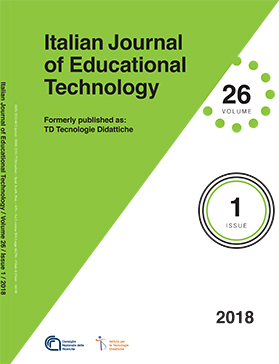Un modulo sulle Tecnologie per l’Apprendimento per insegnanti dell’ istruzione universitaria
Contenuto principale dell'articolo
Abstract
Dettagli dell'articolo
Gli autori che pubblicano su questa rivista accettano le seguenti condizioni:
- Gli autori mantengono i diritti sulla loro opera e cedono alla rivista il diritto di prima pubblicazione dell'opera, contemporaneamente licenziata sotto una Licenza Creative Commons CC BY 4.0 Attribution 4.0 International License.
- Gli autori possono aderire ad altri accordi di licenza non esclusiva per la distribuzione della versione dell'opera pubblicata (es. depositarla in un archivio istituzionale o pubblicarla in una monografia), a patto di indicare che la prima pubblicazione è avvenuta su questa rivista.
- Gli autori possono diffondere la loro opera online (es. in repository istituzionali o nel loro sito web) prima e durante il processo di submission, poiché può portare a scambi produttivi e aumentare le citazioni dell'opera pubblicata (Vedi The effect of Open Access).
Riferimenti bibliografici
Brickner, D. (1995). The effects of first and second-order barriers to change on the degree and nature of computer usage of mathematics teachers: A case study. West Lafayette, IN: Purdue University.
Cronin, C. (2017). Openness and Praxis: Exploring the Use of Open Educational Practices in Higher Education. International Review of Research in Open and Distributed Learning, 18(5), 15-34. doi: 10.19173/irrodl.v18i5.3096
Ertmer, P. (1999). Addressing first- and second-order barriers to change: Strategies for technology integration. Educational Technology Research and Development, 47(4), 47-61. doi: 10.1007/BF02299597
Flynn, S. (2015). Learning Technologists: Changing the Culture or Preaching to the Converted? In D. Hopkins (Ed.), The Really Useful #EdTech Book (p. 199-217). David Hopkins.
Hamilton, E. R., Rosenberg, J. M., & Akcaoglu, M. (2016). The Substitution Augmentation Modification
Redefinition (SAMR) Model: a Critical Review and Suggestions for its Use. TechTrends, 60(5), 433-441. doi: 10.1007/s11528-016-0091-y
Koehler, M. J., & Mishra, P. (2009). What is technological pedagogical content knowledge?. Contemporary Issues in Technology and Teacher Education, 9(1). Retrieved from http://www.citejournal.org/volume-9/issue-1-09/general/what-is-technological-pedagogicalcontent-knowledge/
Laurillard, D. (2012). Teaching as a Design Science: Building Pedagogical Patterns for Learning and Technology. London, UK: Routledge.
Reid, P. (2014). Categories for barriers to adoption of instructional technologies. Education and Information Technologies, 19(2), 383-407. doi: 10.1007/s10639-012-9222-z
Selwyn, N. (2017). Education and Technology: Key Issues and Debates (2nd ed.). London, UK: Bloomsbury Academic.
Wheeler, S. (2012, March 13). New ideas in a digital age.
Retrieved from http://www.steve-wheeler. co.uk/2012/03/new-ideas-in-digital-age.html
White, D., & Le Cornu, A. (2012). Visitors and Residents: A new typology for online engagement. First Monday, 16(9). doi: 10.5210/fm.v16i9.3171

